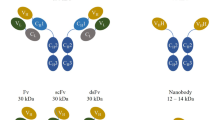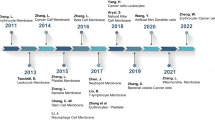Abstract
Purpose
To prepare a nanoparticulate formulation expressing variable peripheral carboxyl density using non-endcapped and endcapped poly(lactide-co-glycolide), conjugated to antibodies recognising the siglec-7 receptor, which is expressed on most acute myeloid leukaemias. The aim is to exploit this receptor as a therapeutic target by constructing an internalising drug-loaded nanoparticle able to translocate into cytoplasm by siglec receptor-mediated internalisation.
Materials and Methods
Antibodies to the siglec-7 (CD33-like) receptor were conjugated to dye-loaded nanoparticles using carbodiimide chemistry, giving 32.6 μg protein per mg of nanoparticles using 100% of the non-endcapped PLGA. Binding studies using cognate antigen were used to verify preservation of antibody function following conjugation.
Results
Mouse embryonic fibroblasts expressing recombinant siglec-7 receptor and exposed to Nile-Red-loaded nanoparticles conjugated to antibody accumulated intracellular fluorescence, which was not observed if either antibody or siglec-7 receptor was absent. Confocal microscopy revealed internalised perinuclear cytoplasmic staining, with an Acridine Orange-based analysis showing red staining in localised foci, indicating localisation within acidic endocytic compartments.
Conclusions
Results show antibody-NP constructs are internalised via siglec-7 receptor-mediated internalisation. If loaded with a therapeutic agent, antibody-NP constructs can cross into cytoplasmic space and delivery drugs intracellularly to cells expressing CD33-like receptors, such as natural killer cells and monocytes.







Similar content being viewed by others
References
J. K. Vasir and V. Labhasetwar. Targeted drug delivery in cancer therapy. Technol. Cancer Res. Treat. 4:363–374 (2005).
P. A. McCarron, S. A. Olwill, W. M.Marouf, R. J.Buick, B. Walker, and C. J. Scott. Antibody conjugates and therapeutic strategies. Mol. Interv. 5:368–380 (2005).
W. L. Monsky, D. Fukumura, T. Gohongi, M. Ancukiewcz, H. A. Weich, V. P. Torchilin, F. Yuan, and R. K. Jain. Augmentation of transvascular transport of macromolecules and nanoparticles in tumors using vascular endothelial growth factor. Cancer Res. 59:4129–4135 (1999).
R. Durand, M. Paul, D. Rivollet, R. Houin, A. Astier, and M. Deniau. Activity of pentamidine-loaded methacrylate nanoparticles against Leishmania infantum in a mouse model. Int. J. Parasitol. 27:1361–1367 (1997).
D. C. Drummond, K. Hong, J. W. Park, C. C. Benz, and D. B. Kirpotin. Liposome targeting to tumors using vitamin and growth factor receptors. Vitam. Horm. 60:285–332 (2001).
P. D. Senter and C. J. Springer. Selective activation of anticancer prodrugs by monoclonal antibody–enzyme conjugates. Adv. Drug Deliv. Rev. 53:247–264 (2001).
Y. Mo and L. Y. Lim. Paclitaxel-loaded PLGA nanoparticles: Potentiation of anticancer activity by surface conjugation with wheat germ agglutinin. J. Control. Release 108:244–262 (2005).
C. Farokhzad, J. J. Cheng, B. A. Teply, I. Sherifi, S. Jon, P. W. Kantoff, J. P. Richie, and R. Langer. Targeted nanoparticle–aptamer bioconjugates for cancer chemotherapy in vivo. Proc. Natl. Acad. Sci. U. S. A. 103:6315–6320 (2006).
J. W. Park, K. Hong, D. B. Kirpotin, G. Colbern, R. Shalaby, J. Baselga, Y. Shao, U. B. Nielsen, J. D. Marks, D. Moore, D. Papahadjopoulos, and C. C. Benz. Anti-HER2 immunoliposomes: Enhanced efficacy attributable to targeted delivery. Clin. Cancer Res. 8:1172–1181 (2002).
J. Huwyler, A. Cerletti, G. Fricker, A. N. Eberle, and J. Drewe. By-passing of P-glycoprotein using immunoliposomes. J. Drug Target. 10:73–79 (2002).
R. H. van der Jagt, C. C. Badger, F. R. Appelbaum, O. W. Press, D. C. Matthews, J. F. Eary, K. A. Krohn, and I. D. Bernstein. Localization of radiolabeled antimyeloid antibodies in a human acute leukemia xenograft tumor model. Cancer Res. 52:89–94 (1992).
L. D. Powell and A. Varki. I-Type lectins. J. Biol. Chem. 270:14243–14246 (1995).
S. J. Orr, N. M. Morgan, R. J. Buick, C. R. Boyd, J. Elloitt, J. F. Burrows, C. A. Jefferies, P. R. Crocker, and J. A. Johnston. SOCS3 Target siglec-7 for proteasomal degradation and blocks siglec-7-mediated responses. J. Biol. Chem. 282:3418–3422 (2007).
P. R. Crocker. Siglecs: Sialic-acid-binding immunoglobulin-like lectins in cell–cell interactions and signalling. Curr. Opin. Struck. Biol. 12:609–615 (2002).
S. J. Orr, N. M. Morgan, J. Elliott, J. F. Burrows, C. J. Scott, D. W. McVicar, and J. A. Johnston. CD33 responses are blocked by SOCS3 through accelerated proteasomal-mediated turnover. Blood 10:1061–1068 (2007).
G. Nicoll, T. Avril, K. Lock, K. Furukawa, N. Bovin, and P. R. Crocker. Ganglioside GD3 expression on target cells can modulate NK cell cytotoxicity via siglec-7-dependent and -independent mechanisms. Eur. J. Immunol. 33:1642–1648 (2003).
M. Falco, R. Biassoni, C. Bottino, M. Vitale, S. Sivori, R. Augugliaro, L. Moretta, and A. Moretta. Identification and molecular cloning of p75/AIRM1, a novel member of the sialoadhesin family that functions as an inhibitory receptor in human natural killer cells. J. Exp. Med. 190:793–802 (1999).
L. Balaian, R. K. Zhong, and E. D. Ball. The inhibitory effect of anti-CD33 monoclonal antibodies on acute myeloid leukaemia (AML) cell growth correlates with Syk and/or ZAP-70 expression. Exp. Hematol. 31:363–371 (2003).
E. Nutku, H. Aizawa, S. A. Hudson, and B. S. Bochner. Ligation of siglec-8: A selective mechanism for induction of human eosinophil apoptosis. Blood 101:5014–5020 (2003).
C. Vitale, C. Romagnani, A. Puccetti, D. Olive, R. Costello, L. Chiossone, A. Pitto, A. Bacigalupo, L. Moretta, and M. C. Mingari. Surface expression and function of p75/AIRM-1 or CD33 in acute myeloid leukemias: Engagement of CD33 induces apoptosis of leukemic cells. Proc. Natl. Acad. Sci. U. S. A. 98:5764–5769 (2001).
E. L. Sievers, F. A. Appelbaum, R. T. Spielberger, S. J. Forman, D. Flowers, F. O. Smith, K. Shannon-Dorcy, M. S. Berger, and I. D. Bernstein. Selective ablation of acute myeloid leukemia using antibody-targeted chemotherapy: A phase I study of an anti-CD33 calicheamicin immunoconjugate. Blood 93:3678–3684 (1999).
M. L. Linenberger. CD33-directed therapy with gemtuzumab ozogamicin in acute myeloid leukemia: Progress in understanding cytotoxicity and potential mechanisms of drug resistance. Leukemia 19:176–182 (2005).
D. H. Nguyen, E. D. Ball, and A. Varki. Myeloid precursors and acute myeloid leukemia cells express multiple CD33-related Siglecs. Exp. Hematol. 34:728–735 (2006).
Y. Mo, and L. Lim. Preparation and in vitro anticancer activity of wheat germ agglutinin (WGA)-conjugated PLGA nanoparticles loaded with paclitaxel and isopropyl myristate. J. Control. Release 107:30–42 (2005).
S. Jaracz, J. Chen, L. V. Kuznetsova, and I. Ojima. Recent advances in tumor-targeting anticancer drug conjugates. Bioorg. Med. Chem. 13:5043–5054 (2005).
M. C. Garnett. Targeted drug conjugates: Principles and progress. Adv. Drug Deliv. Rev. 53:171–216 (2001).
J. Rejman, V. Oberle, I. S. Zuhorn, and D. Hoekstra. Size-dependent internalization of particles via the pathways of clathrin- and caveolae-mediated endocytosis. Biochem. J. 377:159–169 (2004).
M. Koval, K. Preiter, C. Adles, P. D. Stahl, and T. H. Steinberg. Size of IgG-opsonized particles determines macrophage response during internalization. Exp. Cell Res. 242:265–273 (1998).
I. S. Zuhorn, R. Kalicharan, and D. Hoekstra. Lipoplex-mediated transfection of mammalian cells occurs through the cholesterol-dependent clathrin-mediated pathway of endocytosis. J. Biol. Chem. 277:18021–18028 (2002).
P. A. McCarron, R. F. Donnelly, and W. Marouf. Celecoxib-loaded poly(D,L-lactide-co-glycolide) nanoparticles prepared using a novel and controllable combination of diffusion and emulsification steps as part of the salting-out procedure. J. Microencapsul. 23:480–498 (2006).
C. J. Roberts, P. M. Williams, J. Davies, A. C. Dawkes, J. Sefton, J. C. Edwards, A. G. Haymes, C. Bestwick, M. C. Davies, and S. J. B. Tendler. Real-space differentiation of IgG and IgM antibodies deposited on microtiter wells by scanning force microscopy. Langmuir 1:822–826 (1995).
L. Nobs, F. Buchegger, R. Gurny, and E. Allemann. Poly(lactic acid) nanoparticles labeled with biologically active Neutravidin™ for active targeting. Eur. J. Pharm. Biopharm. 58:483–490 (2004).
J. Panyam, S. Sahoo, S. Prabha, T. Bargar, and V. Labhasetwar. Fluorescence and electron microscopy probes for cellular and tissue uptake of poly(D,L-lactide-coglycolide) nanoparticles. Int. J. Pharm. 262:1–11 (2003).
R. G. Anderson and L. Orci. A view of acidic intracellular compartments. J. Cell Biol. 106:539–543 (1988).
J. R. Lake, R. W. Van Dyke, and B. F. Scharschmidt. Acidic vesicles in cultured rat hepatocytes. Identification and characterization of their relationship to lysosomes and other storage vesicles. Gastroenterology 92:1251–1261 (1987).
C. Butor, G. Griffiths, N. N. Aronson, and A. Varki Co-localization of hydrolytic enzymes with widely disparate pH optima: Implications for the regulation of lysosomal pH. J. Cell Sci. 108:2213–2219 (1995).
J. Panyam, W. Z. Zhou, S. Prabha, S. K. Sahoo, and V. Labhasetwar. Rapid endo-lysosomal escape of poly (D,L-lactide-co-glycolide) nanoparticles: Implications for drug and gene delivery. FASEB J. 16:1217–1226 (2002).
A. H. Schinkel and J. W. Jonker. Mammalian drug efflux transporters of the ATP binding cassette (ABC) family: An overview. Adv. Drug Deliv. Rev. 55:3–29 (2003).
Author information
Authors and Affiliations
Corresponding author
Rights and permissions
About this article
Cite this article
Scott, C.J., Marouf, W.M., Quinn, D.J. et al. Immunocolloidal Targeting of the Endocytotic Siglec-7 Receptor Using Peripheral Attachment of Siglec-7 Antibodies to Poly(Lactide-co-Glycolide) Nanoparticles. Pharm Res 25, 135–146 (2008). https://doi.org/10.1007/s11095-007-9400-7
Received:
Accepted:
Published:
Issue Date:
DOI: https://doi.org/10.1007/s11095-007-9400-7




